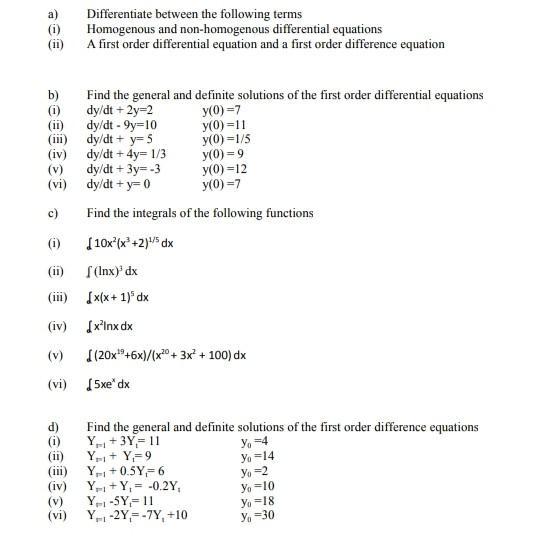Answered step by step
Verified Expert Solution
Question
1 Approved Answer
a) (i) b) (1) (ii) (iii) (iv) (v) (vi) c) (i) (iii) (iv) (v) (vi) d) (i) (ii) (iii) (iv) (v) (vi) Differentiate between

a) (i) b) (1) (ii) (iii) (iv) (v) (vi) c) (i) (iii) (iv) (v) (vi) d) (i) (ii) (iii) (iv) (v) (vi) Differentiate between the following terms Homogenous and non-homogenous differential equations A first order differential equation and a first order difference equation Find the general and definite solutions of the first order differential equations dy/dt +2y=2 y(0)=7 dy/dt - 9y=10 dy/dt+y=5 dy/dt + 4y= 1/3 dy/dt + 3y=-3 dy/dt+y=0 Find the integrals of the following functions [10x(x +2)/5 dx y(0)=11 y(0)=1/5 y(0)=9 y(0)=12 y(0)=7 f(lnx) dx [x(x + 1) dx [xInx dx (20x+6x)/(x20+ 3x + 100) dx [5xe* dx Find the general and definite solutions of the first order difference equations Y + 3Y,= 11 Y =4 Y+Y=9 Y+0.5Y 6 Y+Y = -0.2Y, Y-5Y-11 Y-2Y--7Y, +10. Yo=14 Yo =2 Yo=10 Yo=18 Yo=30
Step by Step Solution
★★★★★
3.49 Rating (159 Votes )
There are 3 Steps involved in it
Step: 1
a Differentiation between terms 1 Homogeneous and nonhomogeneous differential equations Homogeneous differential equation A differential equation is considered homogeneous if all terms involving the d...
Get Instant Access to Expert-Tailored Solutions
See step-by-step solutions with expert insights and AI powered tools for academic success
Step: 2

Step: 3

Ace Your Homework with AI
Get the answers you need in no time with our AI-driven, step-by-step assistance
Get Started


